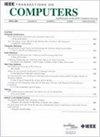A Comprehensive Scan Test Cost Model to Optimize the Production of Very Large SoCs
IF 3.6
2区 计算机科学
Q2 COMPUTER SCIENCE, HARDWARE & ARCHITECTURE
引用次数: 0
Abstract
This paper explores the trade-offs of reducing scan test patterns during Wafer Sort, accepting additional packaging costs, and screening more chips during Package Tests. Previous works proposed ways of selecting or reordering patterns to bring the most efficient to the left. Unlike such studies, this work quantifies the benefit of removing patterns directly from the tail of any pattern set. The paper elaborates on novel formulas to propose a comprehensive cost model that combines yield, Wafer Sort, packaging, and Package Test costs. The model evolves from known concepts by assuming that mass production defectivity is non-uniformly distributed over the die population and accounts for sacrificial lots to extract guiding information. It is shown that reducing patterns at Wafer Sort is beneficial under certain conditions of yield, fault coverage, and considering equipment and production costs. The model accurately estimates the number of patterns to remove for maximum gain in these cases. As a further by-product, the paper shows that a significant cost advantage can be achieved if pattern generation is guided based on the basics of the non-uniform failure distribution. This approach is validated with an academic benchmark and by observing six months of production for a real-world microcontroller by STMicroelectronics.求助全文
约1分钟内获得全文
求助全文
来源期刊

IEEE Transactions on Computers
工程技术-工程:电子与电气
CiteScore
6.60
自引率
5.40%
发文量
199
审稿时长
6.0 months
期刊介绍:
The IEEE Transactions on Computers is a monthly publication with a wide distribution to researchers, developers, technical managers, and educators in the computer field. It publishes papers on research in areas of current interest to the readers. These areas include, but are not limited to, the following: a) computer organizations and architectures; b) operating systems, software systems, and communication protocols; c) real-time systems and embedded systems; d) digital devices, computer components, and interconnection networks; e) specification, design, prototyping, and testing methods and tools; f) performance, fault tolerance, reliability, security, and testability; g) case studies and experimental and theoretical evaluations; and h) new and important applications and trends.
 求助内容:
求助内容: 应助结果提醒方式:
应助结果提醒方式:


